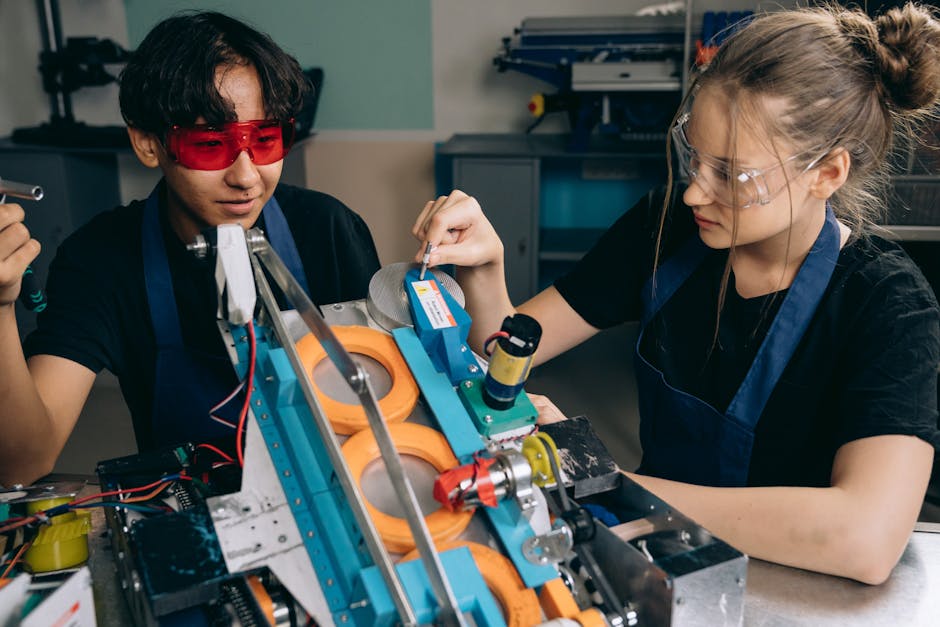Adani Group, Singapore’s ITEES to Launch the World’s Largest Finishing School With AI-Driven Learning - Related to 2025:, launch, bn, create, single
Adani Group, Singapore’s ITEES to Launch the World’s Largest Finishing School With AI-Driven Learning

The Adani Group has partnered with Singapore’s ITE Education Services (ITEES) to launch the world’s largest finishing school in Mundra (Gujarat), as presented by Gautam Adani, chairman of Adani Group, on X.
The initiative aims to train over 25,000 learners annually, supporting India’s skill development and employment efforts.
The facility will also incorporate AI-driven immersive learning and advanced innovation centres to enhance technical training. The programme is aligned with the Make in India movement, aiming to strengthen the country’s workforce by equipping learners with industry-relevant skills.
Gautam Adani (left) with Suresh Natarajan (right), CEO at ITE Education Services.
ITEES, known globally for technical education, will bring expertise in curriculum development and training methodologies. The partnership marks a significant step in advancing India’s vocational education and workforce readiness.
The finishing school is part of Adani Group’s broader efforts to bridge the skill gap in India. The training programme is expected to contribute to economic growth by preparing professionals for various industries.
Last year, Adani Group acquired 25 acres of land parcel in the Pimpri industrial zone of Pune’s Haveli locality from Finolex Industries for around Rs 471 crore. The corporation plans to develop a large data centre on this land.
The Adani Group’s data centre business is led by AdaniConneX, a 50:50 joint venture between Adani Enterprises and US-based global hyperscale data centre provider EdgeConneX. The plan was to develop 1 GW of data centre capacity over the next decade.
With this move, it aimed to become one of the top three data centre operators by 2030, capitalising on India’s increasing digitisation.
At the beginning of 2025, Mukesh Ambani’s Reliance Industries Limited (RIL) also showcased plans to construct what could become the world’s largest data centre by capacity in Jamnagar, India.
This development comes in the backdrop of a global surge in investments in AI infrastructure.
Reliance executives have not yet commented on the project, which is estimated to cost between $20 billion and $30 billion. Currently, the conglomerate has approximately $26 billion on its balance sheet, which could be used to finance the venture.
Decision Tree algorithms have always fascinated me. They are easy to implement and achieve good results on various classification and regression tasks......
India’s global capability centre (GCC) ecosystem is expanding rapidly, set to grow from 1,700 centres in 2024 to 2,100 by 2030. While US-based GCCs co......
Gujarat Launches GCC Policy to Create Over 50,000 Jobs

Gujarat chief minister Bhupendra Patel on Tuesday unveiled the Gujarat Global Capability Centre (GCC) Policy (2025-30) at GIFT City, Gandhinagar. The policy aims to make the state a leading hub for GCCs.
Under the policy, the Gujarat government plans to set up at least 250 new GCCs, attracting over ₹10,000 crore in investment and creating more than 50,000 jobs. The scheme also offers financial incentives, including capital and operational expenditure support, employment assistance, skill development initiatives, and tax benefits.
Speaking at the event, Patel highlighted Gujarat’s commitment to policy-driven growth under Prime Minister Narendra Modi’s leadership. “This initiative has opened new avenues for establishing Global Capability Centres in Gujarat. While these centres were initially set up as cost-saving units, they have now evolved into hubs for innovation and business resilience,” Patal mentioned.
To support businesses, the Gujarat GCC policy offers financial incentives, including capital expenditure (CapEx) support of up to ₹200 crore and operational expenditure (OpEx) support of up to ₹40 crore.
It also includes employment incentives, covering up to 50% of one month’s salary for newly hired local employees, along with an interest subsidy of 7% on term loans, capped at ₹1 crore.
Moreover, eligible companies will receive full electricity duty reimbursement.
The policy emphasises skill development, offering up to 75% reimbursement of training costs for students and working professionals. Furthermore, businesses can benefit from support for quality certification, with up to ₹10 lakh reimbursement to enhance industry standards.
Patel also emphasised Gujarat’s strong infrastructure, industry-friendly policies, and skilled workforce. “Gujarat is ready to become a global leader in the GCC ecosystem, supporting the Prime Minister’s vision of a developed India by 2047.”.
The policy aligns with the Union Budget 2025, which includes a special plan to promote GCCs across India and expand job opportunities in smaller cities.
Last month, Sanjay Dubey, additional chief secretary at the Madhya Pradesh government, revealed on LinkedIn the launch of a GCC Policy 2025.
The state cabinet approved the policy, which builds on the success of the Madhya Pradesh IT, Information Technology Enabled Services (ITES), and ESDM Investment Promotion Policy 2023. This move seeks to transform the state’s tier-2 cities into hubs of global innovation, collaboration, and excellence.
In 2024, the Karnataka government introduced the GCC policy 2024, aiming to bolster its reputation as a global innovation hub while creating [website] lakh jobs by 2029.
L’Europe entre dans une nouvelle ère de puissance militaire, Helsing et Mistral, deux géants de la tech, unissent leurs forces pour développer des sys......
TVS Motor business on Tuesday introduced plans to invest ₹2,000 crore in Karnataka over the next five years to establish a Global Capability Centre (GCC......
Invest Karnataka 2025: State Attracts $115 Bn in Funding, Unveils Single Window Clearance Policy

Invest Karnataka 2025 saw the signing of several significant memorandums of understanding (MoUs), reinforcing the state’s attractiveness to major investors. The Mahindra Group outlined plans to invest approximately ₹40,000 crore to expand its footprint in Karnataka, particularly in renewable energy and electric vehicles.
Similarly, JSW Group committed ₹[website] lakh crore toward increasing its steel production and setting up new facilities in the state.
While not all agreements were disclosed, industry leaders expressed confidence in Karnataka’s industrial-friendly policies and commitment to economic expansion.
In the semiconductor sector, US-based Lam Research inked an MoU with the Karnataka government, pledging ₹10,000 crore to strengthen the state’s growing role in chip manufacturing.
Altogether, these and other investment commitments amount to nearly $115 billion, highlighting Karnataka’s business-friendly environment and focus on sustainable economic expansion.
The Government of Karnataka has launched its Industrial Policy 2024-29, emphasising a streamlined single-window clearance system to enhance investor experience and facilitate ease of doing business.
Deputy chief minister DK Shivakumar introduced the policy on the inaugural day of the Global Investors Meet—Invest Karnataka 2025, in the presence of chief minister Siddaramaiah, industries minister MB Patil, and other senior officials.
The new industrial policy aims to accelerate economic growth, attract investments, and create 20 lakh jobs by 2029. With a target to boost the manufacturing sector’s annual growth rate to 12% and attract investments worth ₹[website] lakh crore, the policy focuses on making Karnataka a leader in sustainable industrial practices.
It also prioritises sunrise sectors such as Electronics System Design & Manufacturing (ESDM), Aerospace & Defense, Advanced Manufacturing, and Future Mobility. Additionally, the government aims to ensure balanced regional development by incentivizing industrial expansion in underdeveloped areas.
One of the key elements of the policy is the recognition of logistics and warehousing as an industry, granting it the necessary support and investment avenues.
To address skill shortages in the sector, the government will roll out specialised workforce training programs, including industry-connected workshops, vocational training, and technical courses in Industrial Training Institutes (ITIs). These efforts aim to bridge skill gaps and create a highly skilled workforce.
A major focus of the new policy is the introduction of flexible subsidy options for investors, allowing them to choose between Production-Linked Incentives (PLI) and Capital Subsidy, depending on their business needs.
Additionally, sustainability initiatives receive significant attention, with incentives offered to industries implementing Zero Liquid Discharge (ZLD), air pollution control, energy efficiency measures, and electrification of thermal processes. Companies with Greenco certification will be eligible for additional benefits.
The policy also encourages the integration of Research & Development (R&D) centers and Global Capability Centers (GCCs) with manufacturing units by offering a 10% additional incentive.
Speaking at the event, Union Minister Rajnath Singh stated that Bengaluru will give India its first foundational AI model. “As India, Bangalore not only creates the future of India but also saves it, driving innovation and progress at national and global scale,” he stated.
I'm an Android user and have been since version [website] of the OS. Over the past year or so, Google has switched its default assistant to its power......
Gujarat chief minister Bhupendra Patel on Tuesday unveiled the Gujarat Global Capability Centre (GCC) Policy (2025-30) at GIFT City, Gandhinagar. The ......
California-based Confluent, the data streaming giant founded by the creators of Apache Kafka, has unveiled a strategic partnership with Jio Platforms......
Market Impact Analysis
Market Growth Trend
| 2018 | 2019 | 2020 | 2021 | 2022 | 2023 | 2024 |
|---|---|---|---|---|---|---|
| 23.1% | 27.8% | 29.2% | 32.4% | 34.2% | 35.2% | 35.6% |
Quarterly Growth Rate
| Q1 2024 | Q2 2024 | Q3 2024 | Q4 2024 |
|---|---|---|---|
| 32.5% | 34.8% | 36.2% | 35.6% |
Market Segments and Growth Drivers
| Segment | Market Share | Growth Rate |
|---|---|---|
| Machine Learning | 29% | 38.4% |
| Computer Vision | 18% | 35.7% |
| Natural Language Processing | 24% | 41.5% |
| Robotics | 15% | 22.3% |
| Other AI Technologies | 14% | 31.8% |
Technology Maturity Curve
Different technologies within the ecosystem are at varying stages of maturity:
Competitive Landscape Analysis
| Company | Market Share |
|---|---|
| Google AI | 18.3% |
| Microsoft AI | 15.7% |
| IBM Watson | 11.2% |
| Amazon AI | 9.8% |
| OpenAI | 8.4% |
Future Outlook and Predictions
The Policy Adani Group landscape is evolving rapidly, driven by technological advancements, changing threat vectors, and shifting business requirements. Based on current trends and expert analyses, we can anticipate several significant developments across different time horizons:
Year-by-Year Technology Evolution
Based on current trajectory and expert analyses, we can project the following development timeline:
Technology Maturity Curve
Different technologies within the ecosystem are at varying stages of maturity, influencing adoption timelines and investment priorities:
Innovation Trigger
- Generative AI for specialized domains
- Blockchain for supply chain verification
Peak of Inflated Expectations
- Digital twins for business processes
- Quantum-resistant cryptography
Trough of Disillusionment
- Consumer AR/VR applications
- General-purpose blockchain
Slope of Enlightenment
- AI-driven analytics
- Edge computing
Plateau of Productivity
- Cloud infrastructure
- Mobile applications
Technology Evolution Timeline
- Improved generative models
- specialized AI applications
- AI-human collaboration systems
- multimodal AI platforms
- General AI capabilities
- AI-driven scientific breakthroughs
Expert Perspectives
Leading experts in the ai tech sector provide diverse perspectives on how the landscape will evolve over the coming years:
"The next frontier is AI systems that can reason across modalities and domains with minimal human guidance."
— AI Researcher
"Organizations that develop effective AI governance frameworks will gain competitive advantage."
— Industry Analyst
"The AI talent gap remains a critical barrier to implementation for most enterprises."
— Chief AI Officer
Areas of Expert Consensus
- Acceleration of Innovation: The pace of technological evolution will continue to increase
- Practical Integration: Focus will shift from proof-of-concept to operational deployment
- Human-Technology Partnership: Most effective implementations will optimize human-machine collaboration
- Regulatory Influence: Regulatory frameworks will increasingly shape technology development
Short-Term Outlook (1-2 Years)
In the immediate future, organizations will focus on implementing and optimizing currently available technologies to address pressing ai tech challenges:
- Improved generative models
- specialized AI applications
- enhanced AI ethics frameworks
These developments will be characterized by incremental improvements to existing frameworks rather than revolutionary changes, with emphasis on practical deployment and measurable outcomes.
Mid-Term Outlook (3-5 Years)
As technologies mature and organizations adapt, more substantial transformations will emerge in how security is approached and implemented:
- AI-human collaboration systems
- multimodal AI platforms
- democratized AI development
This period will see significant changes in security architecture and operational models, with increasing automation and integration between previously siloed security functions. Organizations will shift from reactive to proactive security postures.
Long-Term Outlook (5+ Years)
Looking further ahead, more fundamental shifts will reshape how cybersecurity is conceptualized and implemented across digital ecosystems:
- General AI capabilities
- AI-driven scientific breakthroughs
- new computing paradigms
These long-term developments will likely require significant technical breakthroughs, new regulatory frameworks, and evolution in how organizations approach security as a fundamental business function rather than a technical discipline.
Key Risk Factors and Uncertainties
Several critical factors could significantly impact the trajectory of ai tech evolution:
Organizations should monitor these factors closely and develop contingency strategies to mitigate potential negative impacts on technology implementation timelines.
Alternative Future Scenarios
The evolution of technology can follow different paths depending on various factors including regulatory developments, investment trends, technological breakthroughs, and market adoption. We analyze three potential scenarios:
Optimistic Scenario
Responsible AI driving innovation while minimizing societal disruption
Key Drivers: Supportive regulatory environment, significant research breakthroughs, strong market incentives, and rapid user adoption.
Probability: 25-30%
Base Case Scenario
Incremental adoption with mixed societal impacts and ongoing ethical challenges
Key Drivers: Balanced regulatory approach, steady technological progress, and selective implementation based on clear ROI.
Probability: 50-60%
Conservative Scenario
Technical and ethical barriers creating significant implementation challenges
Key Drivers: Restrictive regulations, technical limitations, implementation challenges, and risk-averse organizational cultures.
Probability: 15-20%
Scenario Comparison Matrix
| Factor | Optimistic | Base Case | Conservative |
|---|---|---|---|
| Implementation Timeline | Accelerated | Steady | Delayed |
| Market Adoption | Widespread | Selective | Limited |
| Technology Evolution | Rapid | Progressive | Incremental |
| Regulatory Environment | Supportive | Balanced | Restrictive |
| Business Impact | Transformative | Significant | Modest |
Transformational Impact
Redefinition of knowledge work, automation of creative processes. This evolution will necessitate significant changes in organizational structures, talent development, and strategic planning processes.
The convergence of multiple technological trends—including artificial intelligence, quantum computing, and ubiquitous connectivity—will create both unprecedented security challenges and innovative defensive capabilities.
Implementation Challenges
Ethical concerns, computing resource limitations, talent shortages. Organizations will need to develop comprehensive change management strategies to successfully navigate these transitions.
Regulatory uncertainty, particularly around emerging technologies like AI in security applications, will require flexible security architectures that can adapt to evolving compliance requirements.
Key Innovations to Watch
Multimodal learning, resource-efficient AI, transparent decision systems. Organizations should monitor these developments closely to maintain competitive advantages and effective security postures.
Strategic investments in research partnerships, technology pilots, and talent development will position forward-thinking organizations to leverage these innovations early in their development cycle.
Technical Glossary
Key technical terms and definitions to help understand the technologies discussed in this article.
Understanding the following technical concepts is essential for grasping the full implications of the security threats and defensive measures discussed in this article. These definitions provide context for both technical and non-technical readers.
platform intermediate
API beginner
 How APIs enable communication between different software systems
How APIs enable communication between different software systems

